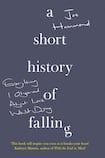
Whatever your opinion may be of Tuesdays with Morrie, Mitch Albom delivers one of the most eloquent description of motor neurone disease, in it. “ALS is like a lit candle: it melts your nerves and leaves your body a pile of wax . . . By the end, if you are still alive . . . your soul, perfectly awake, is imprisoned inside a limp husk . . . like something from a science fiction movie, the man frozen inside his own flesh.”
This gradual disintegration of the body is earnestly recounted in this tender and percipient memoir by Joe Hammond, a writer and playwright whose article in the Guardian about writing 33 birthday cards for his sons he won’t see growing up led up to this book.
In the vein of The Diving Bell and the Butterfly and When Breath Becomes Air, this memoir is revelatory and insightful in getting us acquainted with a debilitating, terminal illness. The writing is incandescent and self-aware as Hammond not only focuses on his rapidly declining health but also puts it into context with what it means for his loved ones.
This book is essentially a love letter to his family, diligently collected memorabilia for his sons when their dad is gone. Hammond faces his life-altering diagnosis with a certain stoicism which prevails even when the escalating handicaps take a serious toll on his life. His insatiable scientific curiosity is evident from his claim that the incremental changes in his body were terrifying for him as a person but exciting for the writer in him.
Motor neurone disease
A clown foot and a limp were the first harbinger of the motor neurone disease that would soon latch on to Hammond’s body and take over like termites in wood. Gradually he would lose the faculty of his legs, then his arms and, by the very end, his neck. Hammond chronicles the vagaries of this merciless illness with an almost detached scrutiny. ALS is described by the writer by employing a metaphor of a steel suspension bridge where with time, the cables supporting the stanchions are snapping one by one and the bridge starts wobbling and creaking.
What radiates from the narrative is deep compassion and gratitude for his family. Hammond comes across as a thorough family man who, maybe as a counteraction to his unstable parental figures, has worked his hardest towards being the best father and husband to his family. The bulk of his reverence is reserved, deservedly so, for his wife Gill, who takes on the superhuman task of caring for a terminal patient while juggling being a mother of two small kids.
In one chapter, Hammond describes one of his “quotidian falls”. By that point, his falling had become normal for him and his family. While his sons would initially be aghast at their dad’s fall, now they would barely bat an eyelid depicting “the transition along the scale from horror to tedium”.
Terminally ill
He talks about how since childhood he had always dreamt of falling, which might be what accounts for the title of this book. He used to have a curious dream where his job was to hold several items and make sure nothing falls or else, everything would end. This potent need to make sure everything hangs in balance seems to continue through adulthood. Since his diagnosis, his main concern is to ensure that the tight little orbit of his family stays intact.
Interspersed in the narrative are commonplace observations about how being a terminally ill person impacts how other people view you. For instance, Hammond notes how London beggars don’t ask for money or make eye contact with you if you are disabled. He observes how impatient, even aggressive, well-wishers are in offering him futile cures for his incurable disease to ward off their fear of death. There are also moments of wry irony such as when he reads in his medical report the words “emerging quadriplegia” and ironically comments how he was once an “emerging” playwright, the word itself implying aspiration, with status connotations.
Paul Kalanithi wrote in his acclaimed memoir that grand illnesses are supposed to be life-clarifying. This is evident in this book as the writer categorically focuses on his wife, sons and his parent’s influence on his life choices. Hammond is sensitive to the fact of how his boys will process the concept of mortality. He goes into length about his fractious relationship with his dad, who was a non-conformist who lived his life by “absenting himself”. Hammond handles his ambivalent feelings toward his dad with inspiring discernment, without harbouring anger against him, concluding that he just wasn’t fit for the job of a father.
A melancholic feeling of helplessness seeps into the narrative in the latter half when Hammond has lost even basic voluntary movements. There is a tacit acceptance of the inevitability of death which propels contemplative, conscientious reflections. A Short History of Falling is a brave, stirring memoir of a man staring down the barrel of his own mortality.










